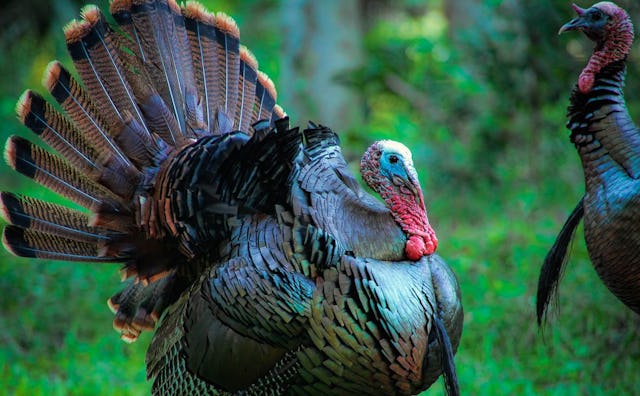What If the Turkey Were Our National Symbol?

Roughly 240 years ago, when the founding fathers were debating what the great seal of the United States should look like, they settled on a design that incorporated the bald eagle. Dissenter Ben Franklin, as you may have heard in school, preferred creating a symbol out of the noble wild turkey. In the end he lost the debate and the eagle flew into its position of national symbolism.
I may have read too many Harry Turtledove alternate history novels as a kid, but I’m fascinated by the notion that a seemingly small decision might have far-ranging impact on our lives. Suppose Franklin had won, and we had adopted the turkey. Would we eat them with such fanfare? Would we hurl them at each other as G-rated insults?
Let’s take it a step further. Can our choice of symbols have a sort of reverse, life-imitates-art effect on our national character and destiny? Take our national bird, for example. The bald eagle is a bird of prey that swoops from the sky and is capable of feeding on fish, other birds, and mammals. Wild turkeys are omnivores, but foragers as opposed to hunters—more likely to eat acorns and nuts than to chow down small reptiles and amphibians. What effect would choosing a forager over a hunter have had on us as a nation? Would it have impacted at all our 19th-century notions of Manifest Destiny, or our willingness to use force abroad in the 20th and 21st centuries?
If the turkey as national symbol doesn’t convince you, how about our choice of national colors? The red, white, and blue of the American flag was an easy choice because of the original colonies’ former status as part of the British Empire, the flag of which contains similar colors. While there was no overt symbolism associated with the colors at first, over time they’ve taken on additional meaning.
“White signifies purity and innocence. Red, hardiness & valour, and Blue…signifies vigilance, perseverance & justice,” Charles Thomson, Secretary of the Continental Congress, said after the great seal (which contained the same colors as the flag) was presented.
There’s even a hidden symbolism behind the stars and stripes themselves that you may never have been told about.
Growing up in America, you probably learned in school that the red actually stood for the blood that U.S. soldiers spilled on behalf of the country. In declaring 1986 the “Year of the Flag,” President Reagan took it a bit further: “The colors of our flag signify the qualities of the human spirit we Americans cherish,” Reagan said. “Red for courage and readiness to sacrifice; white for pure intentions and high ideals; and blue for vigilance and justice.”
There’s even a hidden symbolism behind the stars and stripes themselves that you may never have been told about. According to Time.com, a 1977 book produced by the House of Representatives says that the stars symbolize “the heavens and the divine goal to which man has aspired from time immemorial; the stripe[s are] symbolic of the rays of light emanating from the sun.”
Fantastic things to symbolize, certainly—but what if we’d decided that they held other meanings, things that I think many of us would articulate in addition to some of our other values? For example, could the white represent gratefulness for the vastness of our country and our resources, or could the blue symbolize the idea of living peacefully among ourselves or with other nations?
Let’s take one more national symbol, our national anthem, “The Star Spangled Banner,” which was actually the shared song of the U.S. armed forces before it was adopted by President Wilson in 1916. It’s about a battle during the War of 1812. Could its martial lyrics have an impact on our national character? Would things be different if we’d chosen instead the more pacific “God Bless America”? Granted, the latter song was only written in 1918 by Irving Berlin, so it wasn’t as if Wilson could have chosen it two years earlier.
Maybe I’m wrong. Maybe our choices of symbols are random, or simply the whims of those with the power to choose them, and have no true net effect on how we think of ourselves as Americans. Maybe. But if you’re on the fence, here’s one more thing to consider—while Franklin advocated for the turkey, that wasn’t actually his first choice. Instead, he wrote in 1775 that he would have preferred the rattlesnake.
This article was originally published on